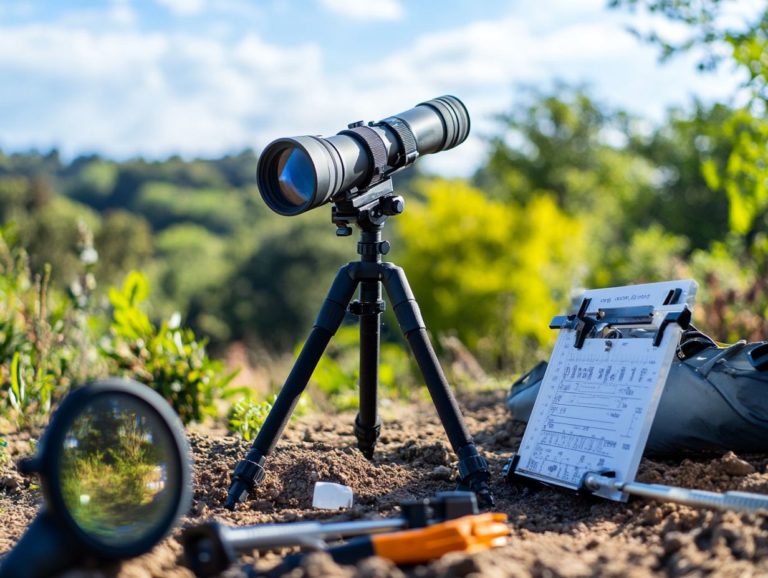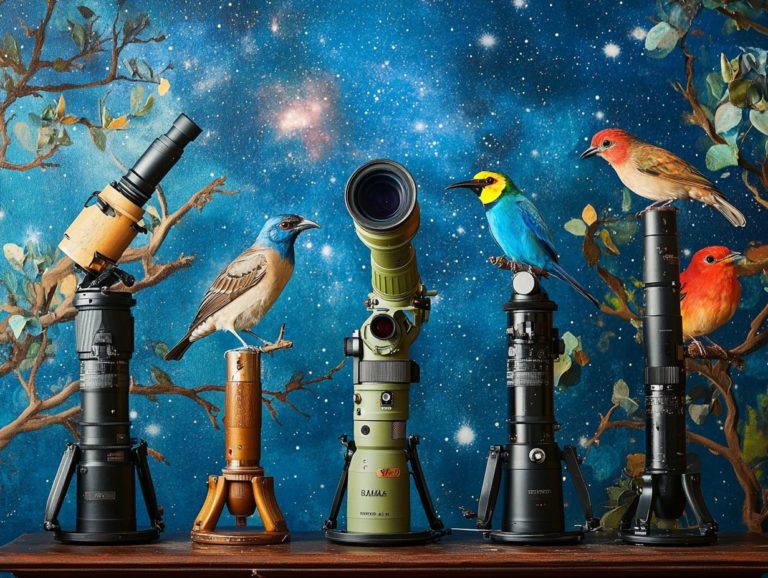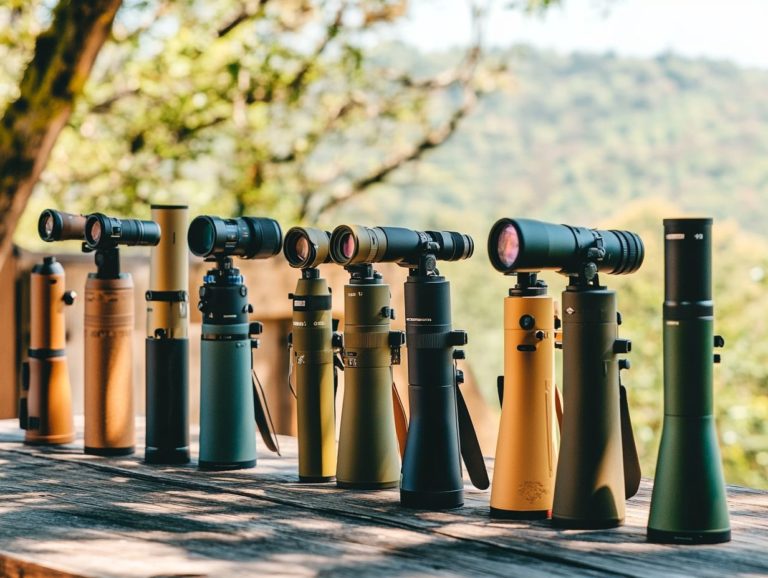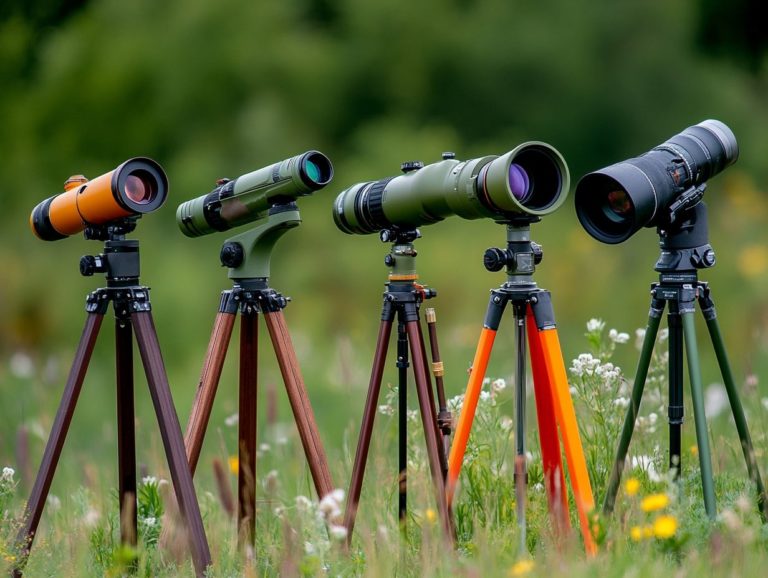5 Essential Features for Bird Watching with Scopes
Bird watching is a fun activity that invites you to connect deeply with nature and enjoy the beauty of birds.
Choosing the right scope can elevate your experience, turning your outings into memorable adventures.
This article covers five essential features every bird watcher should consider when selecting a scope.
From top-notch optics to durable designs, it highlights what makes a scope stand out. Get ready to discover tips that will supercharge your birdwatching adventures!
Contents
- Key Takeaways:
- 1. High-Quality Optics
- 2. Lightweight and Portable Design
- 3. Wide Field of View
- 4. Waterproof and Fogproof
- 5. Durability and Longevity
- What Is Bird Watching with Scopes?
- Why Are These Features Essential for Bird Watching with Scopes?
- How Can One Choose the Right Scope for Bird Watching?
- What Are the Different Types of Scopes Available for Bird Watching?
- What Are Some Other Important Considerations for Bird Watching with Scopes?
- How Can One Make the Most Out of Bird Watching with Scopes?
- Frequently Asked Questions
- What are the 5 essential features for bird watching with scopes?
- Why is magnification important for bird watching with scopes?
- How does lens size affect bird watching with scopes?
- What is the significance of field of view for bird watching with scopes?
- Why is a good focus system necessary for bird watching with scopes?
- How does durability play a role in bird watching with scopes?
Key Takeaways:
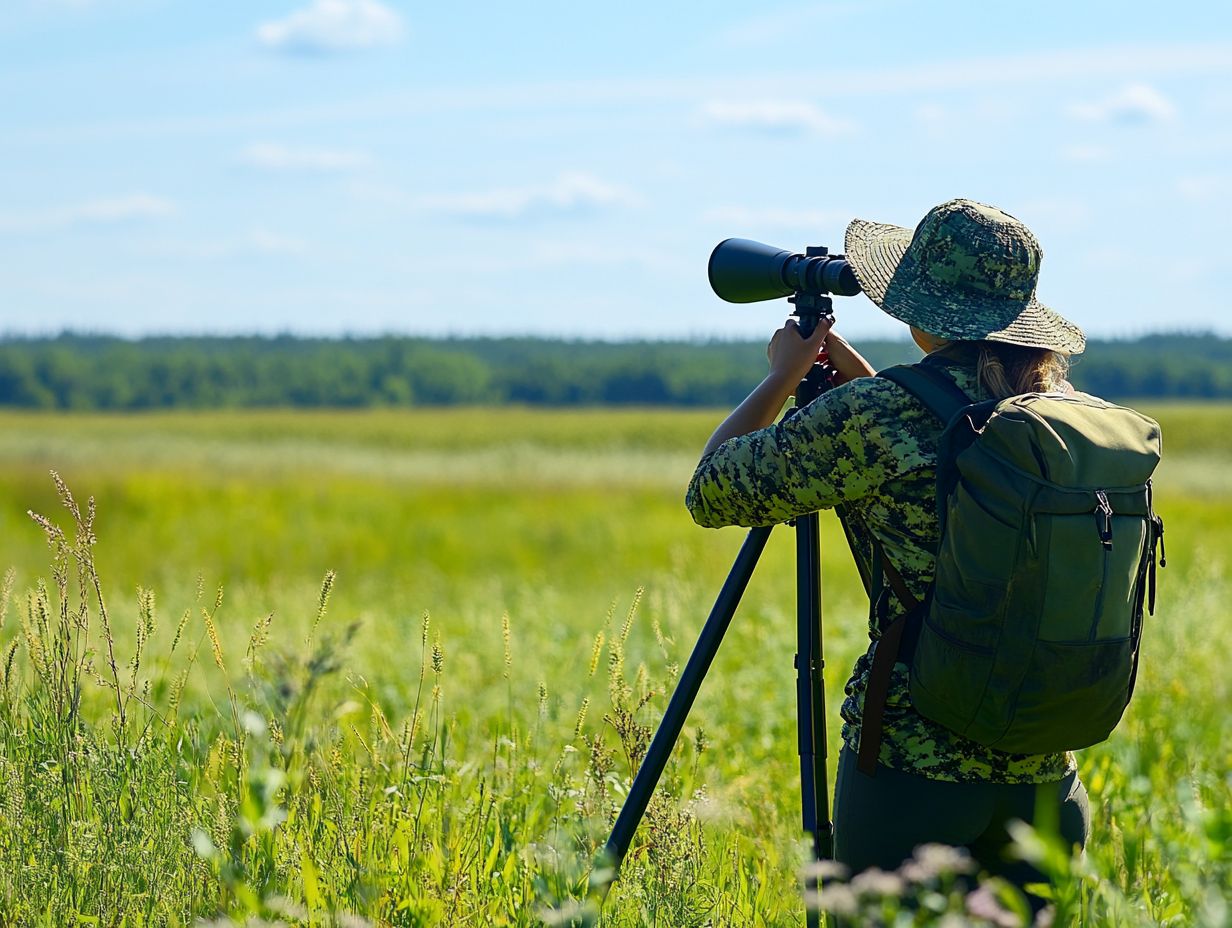
- High-quality optics are essential for sharp, clear views of birds.
- A lightweight and portable design allows for easy maneuvering while observing wildlife.
- A wide field of view enables you to track birds more easily.
1. High-Quality Optics
High-quality optics are crucial for birders and wildlife enthusiasts looking for the best scopes and binoculars. In stunning locations like the Great Smoky Mountains and Kaziranga National Park, every detail matters.
Consider options from leading brands like Nikon, Zeiss, Leica, and Swarovski available on Amazon. Look for factors like magnification power, which typically ranges from 8x to 12x, crucial for bringing distant birds into focus.
A larger objective lens gathers more light, especially beneficial during early morning or late evening bird activity.
Advanced lens coatings reduce reflections and enhance contrast, making colors and patterns pop. Brands like Nikon and Zeiss use ED glass in their designs to minimize color distortion and improve optical performance, enhancing your viewing experience.
This combination of features not only improves your birdwatching but also helps you appreciate avian beauty and behavior.
2. Lightweight and Portable Design
The lightweight and portable design of spotting scopes and binoculars is vital for birders, especially during long outings in the wilderness. You don t have to compromise comfort or usability.
This adaptability keeps you mobile across various habitats, from dense forests to expansive wetlands. Made from advanced materials like carbon fiber and high-grade aluminum, these instruments offer a fantastic mix of durability and lightness.
Features like compact folding designs and adjustable tripods ensure stability on various terrains, which is crucial for capturing clear images of fast-moving birds.
Ultimately, these designs cater to your need for convenience, allowing for longer journeys and richer experiences in the great outdoors perfect conditions for birdwatching.
3. Wide Field of View
A wide field of view is essential for birdwatchers, allowing you to capture more of the environment in your scopes and binoculars. To enhance your experience, consider these essential tips for using your spotting scope. This feature makes it easier to track fast-moving wildlife and observe their natural behaviors.
This capability is especially advantageous during migration seasons or in habitats where birds exhibit unpredictable flight patterns. Models like the Vortex Razor HD 10×42 binoculars and Nikon Monarch 7 offer exceptional wide fields of view, letting you follow flocks or individual birds with ease.
These optics help you notice subtle movements and distinguish between similar species in lush habitats. With a broader perspective, you can immerse yourself in the ecosystem, enriching your experience as you connect with nature and deepen your understanding of avian behaviors.
4. Waterproof and Fogproof

Waterproof and fogproof construction in spotting scopes and binoculars is essential for birders, especially when facing unpredictable weather in the field. These features protect your gear, ensuring it remains functional and reliable in various environments.
With these protective elements, the inside parts are protected from water, humidity, and temperature fluctuations. This allows you to immerse yourself in birdwatching without worrying about equipment failure.
For example, brands like Nikon offer waterproof models such as the Prostaff 7S binoculars, expertly crafted for heavy rain. Meanwhile, the Vortex Diamondback series provides fogproof performance thanks to nitrogen purging. Both options showcase how quality construction can significantly enhance your birdwatching experience, giving you the power to capture breathtaking sightings even in challenging conditions!
5. Durability and Longevity
Durability and longevity are vital qualities to seek in spotting scopes and binoculars. These attributes ensure your optical devices endure outdoor adventures while delivering reliable performance for years.
This resilience stems from critical factors, notably the materials used in their construction. Premium-grade optics feature reinforced housing made from materials like aluminum or polycarbonate. These materials protect against drops and bumps while resisting corrosion from moisture and dust.
A robust design, complemented by features like rubber armoring, enhances grip and shock resistance, making these optics perfect for challenging environments. By investing in equipment with these key attributes, you can elevate your outdoor experiences, ensuring your gear remains dependable, even in nature’s unpredictability as a dedicated birder.
What Is Bird Watching with Scopes?
Birdwatching with scopes is an engaging endeavor that allows you to observe avian wildlife up close. By using advanced spotting scopes or high-quality binoculars, you significantly enhance your viewing experience. To maximize your observations, consider the unique features in high-end spotting scopes. You can even take stunning images of birds in their natural habitats using your smartphone for digiscoping, taking photos through your scope!
Integrating these optical devices into your excursions enables you to observe intricate details of plumage and behavior, immersing yourself in the beauty of various species. Spotting scopes magnify images, perfect for seeing distant birds, while binoculars offer portability and ease, ideal for trails or wooded areas.
The trend of digiscoping blends traditional birdwatching with digital photography, allowing you to document encounters effectively. With a smartphone and the right adapter, you can capture high-resolution photos, turning fleeting moments into lasting memories and deepening your connection to nature!
Why Are These Features Essential for Bird Watching with Scopes?
The features of spotting scopes and binoculars, such as image quality and magnification power, are crucial for your birdwatching adventures. For an enhanced experience, check out local bird watching spots for your spotting scope. These features directly affect your ability to observe and identify various species in diverse environments.
In terms of image quality, you want details feather patterns, color variations, and subtle markings to be clear. This clarity enhances your capacity for accurate identifications. Magnification power is equally important; it allows you to observe birds from a distance without disturbing them, essential for witnessing their natural behaviors.
A wider field of view can enhance your experience, making it easier to track moving birds and spot them in dense foliage. Collectively, these features create an optimal viewing experience that enriches your birdwatching journey and boosts your chances of identifying elusive species.
How Can One Choose the Right Scope for Bird Watching?
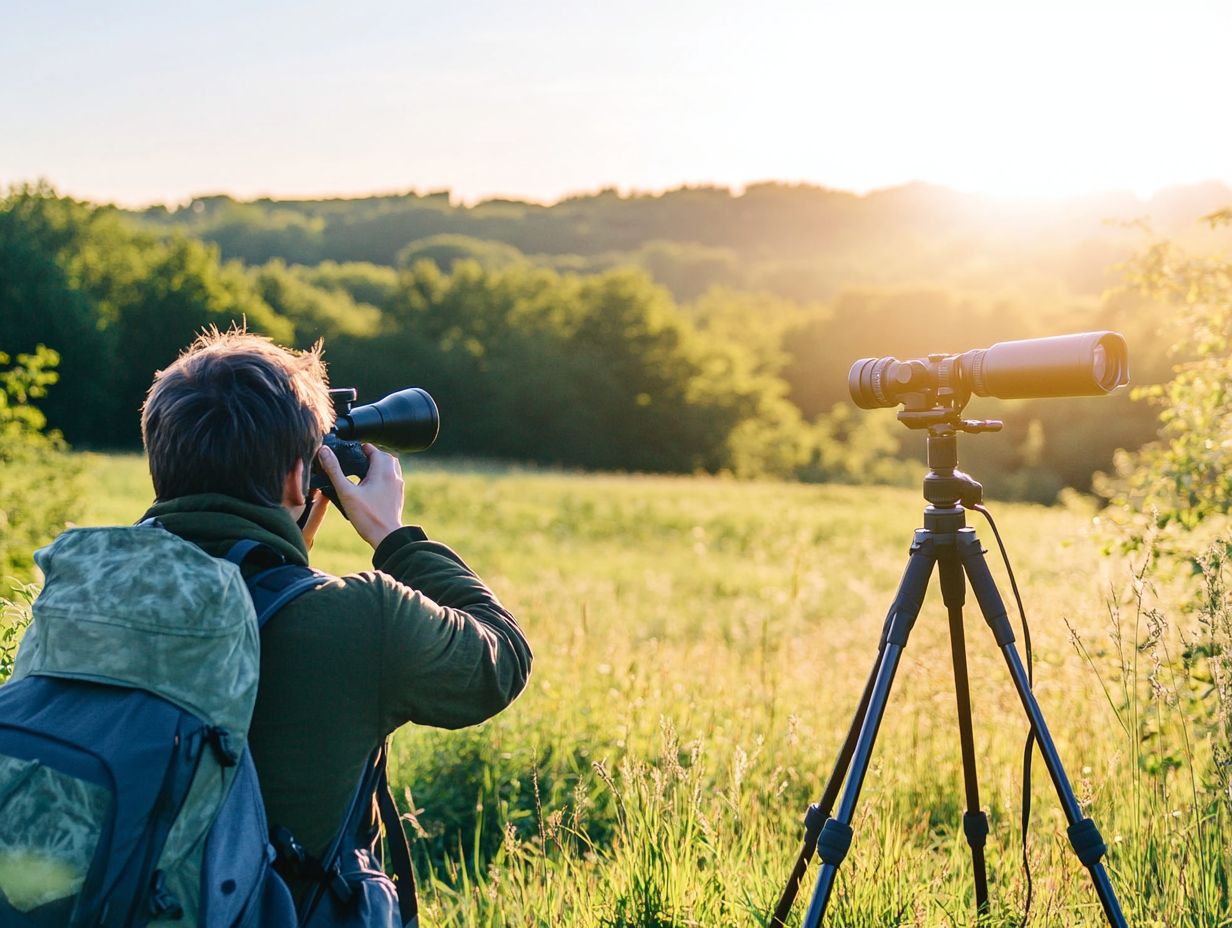
Choosing the right scope for your birdwatching adventures can feel overwhelming at times. You need to consider various factors like magnification power and field of view. To make an informed decision, it’s helpful to know the top features to look for in a spotting scope. Understanding your specific needs as a birdwatcher will help ensure you select the perfect spotting scope or binoculars.
When making this investment, think about the type of birdwatching you plan to do, whether it’s casual observing in your local park or serious field research in remote areas. The ideal scope should provide a crystal-clear image and enhance your experience by enabling you to spot elusive species, so consider the 8 essential features of bird watching binoculars.
Features like light transmission capabilities greatly impact performance in low-light conditions. A higher magnification range allows you to appreciate greater detail from afar. Ultimately, understanding your personal preferences and the environments you typically explore will guide you to the best choice.
What Are the Different Types of Scopes Available for Bird Watching?
You’ll find a range of scopes available for birdwatching, from traditional spotting scopes with angled eyepieces to those boasting variable magnification. If you’re considering binoculars, check out the top 5 features to consider in bird watching binoculars. Each type is thoughtfully designed to meet the unique preferences and needs of birders like you, enhancing your wildlife observation experience.
Understanding the subtle differences between these options can genuinely elevate your time in the field. For instance, angled eyepieces offer a comfortable viewing angle, especially beneficial when you’re observing birds perched high in trees or at considerable distances. This design reduces neck strain during long hours of observation.
Variable magnification allows you to adjust the power of your scope based on the distance of your subject. This feature is invaluable for capturing finer details of elusive or fast-moving birds. It enables you to transition effortlessly from observing species hiding in dense underbrush to inspecting those soaring majestically in the open sky.
What Are Some Other Important Considerations for Bird Watching with Scopes?
Start your birdwatching adventure with scopes by considering several key factors, such as exit pupil, eye relief, lens coatings, and tripod stability. For more insights, check out these tips for spotting birds with a scope. Each of these elements can significantly influence your comfort and the effectiveness of your experience.
The exit pupil is the diameter of the beam of light entering your eye. A larger exit pupil typically makes it easier to track fast-moving birds in varying light conditions. Eye relief refers to the distance from the eyepiece where your eye can be positioned. This is crucial for those who wear glasses, ensuring a full field of view without sacrificing clarity.
By thoughtfully combining these aspects, you enhance viewing comfort and elevate the entire birdwatching experience. This allows you to appreciate nature’s beauty through the optical devices that help you see it better without distractions.
How Can One Make the Most Out of Bird Watching with Scopes?
To elevate your birdwatching experience, adopt a range of techniques and tips that truly enhance your time outdoors. Understand bird behavior and select the right equipment, such as digiscoping setups, for successful sightings. Digiscoping means using your scope with a camera for high-quality photos.
Identifying the optimal times for bird activity think dawn and dusk can significantly boost your chances of encountering a variety of species. Familiarize yourself with the calls and behaviors of local birds for quick identification, making it easier to focus your scope on the right targets.
Choosing a quiet, unobtrusive location is wise; minimizing disturbances creates a welcoming space for birds to thrive. Adjusting your scope for comfort and employing stabilization techniques can dramatically improve clarity and detail. This ensures a rewarding and immersive birdwatching experience with your smartphones and digiscope adapter.
Frequently Asked Questions
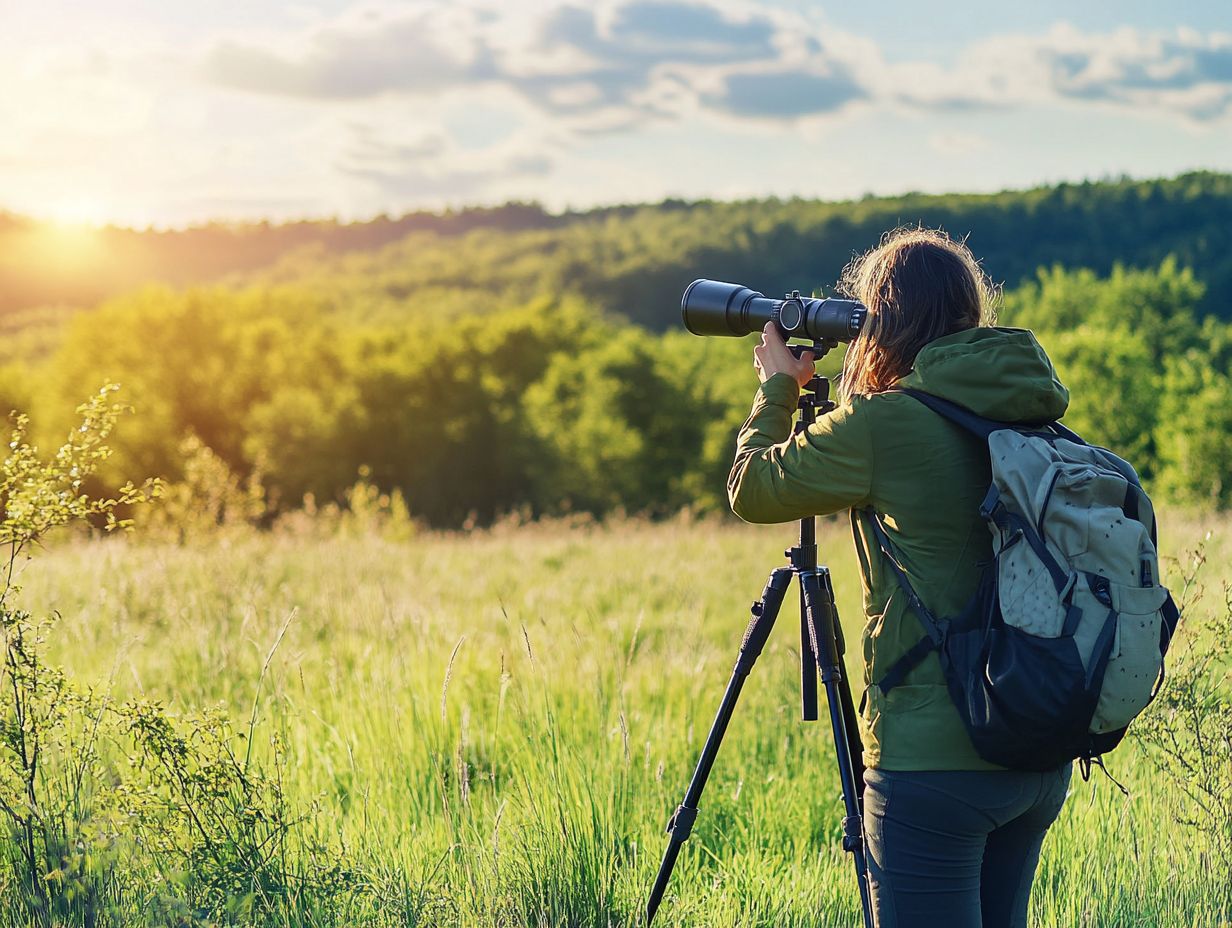
What are the 5 essential features for bird watching with scopes?
The five essential features for bird watching are magnification, lens size, field of view, focus system, and durability. For more information on these aspects, check out the 5 essential features for spotting scope success. Considerations like waterproof construction and ED glass (Extra-low Dispersion glass) also play an important role.
Why is magnification important for bird watching with scopes?
Magnification helps you see birds in greater detail from a distance. This enhances your overall bird watching experience.
How does lens size affect bird watching with scopes?
Lens size affects the amount of light entering the scope. A larger lens results in a brighter and clearer image.
What is the significance of field of view for bird watching with scopes?
A wider field of view makes spotting birds easier. It allows you to track their movements without frequent scope adjustments.
Why is a good focus system necessary for bird watching with scopes?
A good focus system helps you adjust the scope quickly. This ensures you don t miss any important details of the bird.
How does durability play a role in bird watching with scopes?
Bird watching often happens outdoors, so durability is key. Reliable brands like Nikon, Zeiss, Leica, Swarovski, and Celestron provide scopes that can withstand the elements and last for years.

